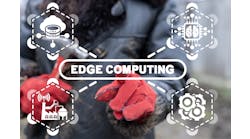By Dino Busalachi, CTO and co-Founder Velta Technology, a partner member of the Control System Integrators Association (CSIA)
Edge computing takes place where data is collected, enabling real-time decision-making based on data collected from internet-connected sensors on factory floors, transport networks, retail outlets and remote locations. You already know this. By 2025, Gartner predicts that more than 50% of enterprise-managed data will be created and processed outside the data center or cloud.
OEMs and system integrators (SIs) are developing and designing technologies to improve the compute capabilities at the edge. They are looking at ways to orchestrate and provision HMIs, PLCs, and OT cybersecurity (platforms, sensors) at the edge to collect metadata, performing machine learning and introducing greater AI capabilities at the edge.
We are seeing continuous growth in edge analytics, especially in use cases where reduced latency is required to act upon real-time data. To facilitate this, edge is now getting "foggy." Fog computing, as it's known, is "edge to the edge." It brings processing to the edge further in terms of more computation, storage and communication, facilitated by micro datacenters. Consider Meta, which continues to invest in more network opportunities for the Metaverse as it recognizes how edge computing can take pressure off the public cloud, thus providing a faster customer experience.
In the next five years, chips and operating systems will get optimized for edge and companies will adopt ultralow latency 5G networks—both core components of the Industrial internet of things (IIoT). This will help accelerate the next generation of automation and will open a variety of new AI use cases.
OT cybersecurity people, process, organizations, technologies are maturing toward OT adoption in a few ways.
IT & OT convergence will expand their audiences
From an OT perspective this includes third parties—machine builders / OEMs, SIs, process-control engineering and local manufacturing operations teams.
Gaining OT acceptance via OT adoption
Industry digitization efforts require rigorous commitment to good cybersecurity design and support as OT-cybersecurity technologies are introduced into the industrial environment. OT will need to lead their digital safety efforts to secure and protect their OT environments. IT is not equipped to deal with a wide range of industrial assets or proprietary and unique industrial applications. The IT toolsets are incompatible for the OT environment, and enterprise practices are disruptive and cause costly downtime for plant floor operations.
OT-specific SOC
Industrial organizations need visibility into what’s connected to their industrial networks, both to maintain a detailed asset inventory that SecOps (either IT / OT or both) require to protect the environment, and to help monitor/troubleshoot industrial operations. We are starting to see OT-specific SOCs coming into the market (Velta Technology, Rockwell, 1898), as well as hybrid SOCs (Crowdstrike, Mandiant) that blend IT & OT.



